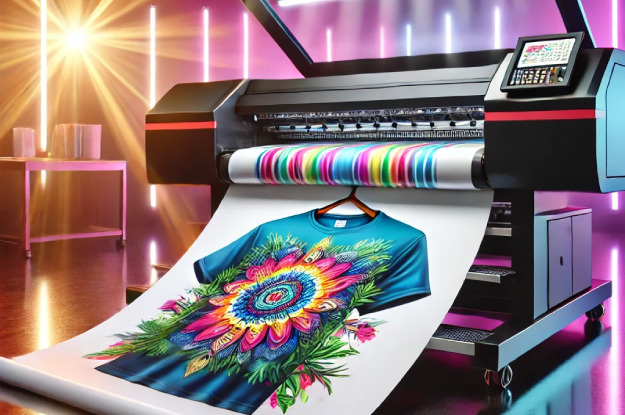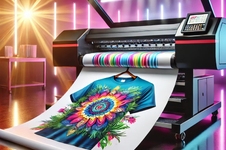In the fast-evolving world of fashion, merchandise, and digital art, staying ahead of trends is crucial—and for modern designers, that means keeping up with the tools that bring creativity to life. One of the most transformative innovations in custom printing today is the DTF printer, or Direct to Film printer.

At first glance, DTF printing may seem like something only manufacturers or print shops should worry about. But if you're a designer—whether in fashion, branding, streetwear, or digital illustration—DTF printers should absolutely be on your radar.
In this blog, we'll dive into why DTF printers are becoming essential for designers, how they influence your workflow, and how understanding this technology can elevate your creative career or business.
What Is a DTF Printer? A Quick Refresher
DTF (Direct to Film) printing is a technique that prints a design onto a special PET film using textile ink and a layer of hot melt powder. The printed film is then transferred onto fabric using a heat press. Unlike screen printing or DTG (Direct to Garment), DTF printers don’t require pretreating garments and can be used on almost any fabric type—cotton, polyester, blends, leather, and more.
Why Should Designers Care About DTF Printers?
🎨 1. Freedom to Create Without Limits
Designers love freedom—and DTF printing offers just that. Because DTF prints adhere to nearly any fabric, designers aren’t restricted to designing only for cotton tees or specific textiles.
You can design for:
- T-shirts
- Hoodies
- Tote bags
- Denim jackets
- Hats
- Leather accessories
- Synthetic sportswear
DTF gives you the confidence that your designs can live on any medium your client demands or your imagination dreams up.
⚡ 2. Design Accuracy and Color Vibrancy
As a designer, your vision is only as good as its execution. DTF printers use vibrant CMYK + White inks, delivering high-resolution prints with crisp lines and brilliant colors—even on dark fabrics.
Why this matters:
- No compromise on gradient effects or fine details
- Bold colors pop regardless of garment shade
- Intricate artwork like hand lettering or fine illustrations comes out sharp
For artists who obsess over pixel-perfect designs, DTF technology ensures your work shows up exactly as you intended.
💡 3. Fast Prototyping = Faster Feedback
When working with clients, speed and accuracy are key. Instead of waiting days for outsourced samples, DTF printers allow for fast, in-house prototyping.
Imagine this:
- You create a design for a fashion brand.
- Instead of sending it to a print shop and waiting a week, you print a sample yourself or collaborate with a DTF print partner nearby.
- The client sees a physical prototype within 24 hours.
This rapid design-to-product cycle boosts your professionalism and gives you a competitive edge.
💰 4. Monetization Opportunities
Many designers are turning their skills into profitable print-on-demand brands. Understanding how DTF printers work opens up new income streams.
With DTF printing, you can:
- Start your own merch line with minimal investment
- Offer custom apparel design + printing packages
- Sell digital art files specifically optimized for DTF
- Partner with local printers for small-batch collaborations
The low setup cost and broad fabric compatibility mean you can launch a clothing brand without traditional limitations.
🧠 5. Better Collaboration with Print Shops
When designers understand how printing works, communication with production partners becomes easier and more effective.
Knowing DTF printing basics helps you:
- Deliver files in the correct format (usually 300 DPI PNG with transparency)
- Design with underbase and ink layering in mind
- Avoid layout issues or incorrect color profiles
This reduces revisions, streamlines production, and makes you a more desirable designer for high-volume brands or printers.
📦 6. No Minimum Order Limitations
Unlike screen printing, which often requires bulk orders due to setup costs, DTF printing allows single-item runs at a reasonable price. This is a game-changer for designers working with:
- Indie fashion labels
- Niche merch drops
- Limited edition releases
- Personalized gift clients
You no longer have to hold inventory or meet high minimums. You can produce exactly what’s needed, when it’s needed.
🌿 7. Support for Sustainable Design
Eco-conscious design is on the rise. While DTF is not yet the gold standard in sustainability, it does offer some green advantages:
- Less water use compared to traditional screen printing
- Less waste from unused ink or rejected batches
- Fewer chemicals due to no need for pre-treatment
Designers working with brands focused on sustainability can use DTF printing as a more eco-aligned production option.
🔧 8. Custom Packaging, Tags, and Accessories
DTF isn’t just for garments. As a designer, you can extend your brand by offering:
- Custom tags and labels
- Branded tote bags
- Stickers printed on film
- Heat transfers for third-party application
This opens up opportunities for brand kits, launch packs, or comprehensive client branding packages—all powered by your design and DTF technology.
How to Get Started with DTF as a Designer
You don’t necessarily need to buy a DTF printer to start leveraging its benefits. Here’s how you can start:
- Learn the Basics: Understand resolution requirements, ink behavior, and how to set up files for DTF.
- Partner with a Local DTF Print Shop: Send your designs and test small batches. Build a relationship with them.
- Offer Mockups to Clients: Use your designs to create realistic apparel mockups to pitch DTF solutions.
- Join DTF Communities: Follow Reddit threads, Facebook groups, and YouTube tutorials to stay informed.
- Eventually, Consider Investing: If you handle volume or want creative control, investing in an A3 or 24-inch DTF setup may be worthwhile.
Conclusion: Creativity Meets Capability
As a designer, your impact goes beyond screens—it touches brands, culture, and physical products. Embracing DTF printers as part of your workflow doesn’t mean you need to become a print technician—it means you’re empowering your art to be seen, worn, and remembered across a wider range of formats.
Whether you want to bring your portfolio to life, launch a clothing brand, or collaborate more effectively with clients, DTF printing gives you the tools to do so creatively and efficiently.
So, if you haven’t explored the possibilities of DTF printers yet—now’s the time. Because the future of design isn’t just digital. It’s wearable.
